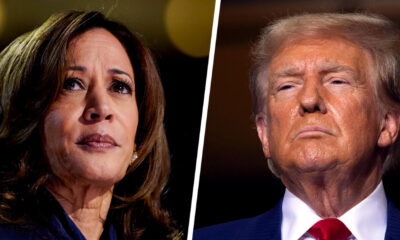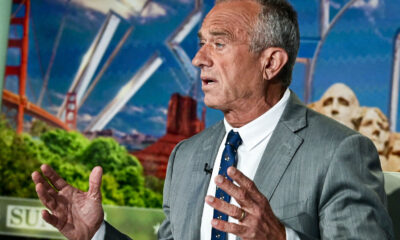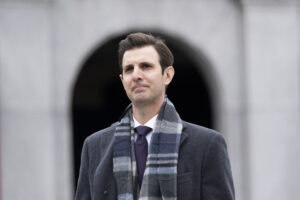The Dictatorship
The absurd defense of Trump boosters claiming they didn’t vote for this crisis

Before President Donald Trump’s expanded tariffs went into effect on Wednesdayhedge fund billionaire and You’re Fan Bill Ackman warned over the weekend on X that the country was “heading for a self-induced, economic nuclear winter.” As he contemplated the pain ahead, he sounded mournful, perhaps even regretful: “This is not what we voted for.”
Many other conservative commentators and investors have echoed Ackman’s sentiment as Trump’s radical tariff plans have rocked global markets. And it is absurd. Trump has advocated for protectionist trade policy for decadeslong before running for president. He also repeatedly proposed economically disastrous plans to institute tariffs on the 2024 campaign trail. Ignoring that required ignoring the historical truth that presidents generally pursue their core policy agenda — even Trump.
The denialism on the right has been remarkable.
The denialism on the right has been remarkable. Some right-wing pundits have argued that the current crisis is a surprise because Trump never presented on the campaign trail this specific — and economically nonsensical — tariff formula for extremely high duties on imports from scores of countries around the world. Business and tech leaders — who showered Trump with money in hopes of favorable treatment — have reportedly been surprised by Trump’s fierce commitment to tariffs. Mega-billionaire Elon Musk, who recently wore a hat emblazoned with the words “Trump was right about everything!” has reportedly been directly appealing to Trump to drop the tariffs.
The claim that Trump is pursuing a trade policy that goes beyond what they voted for is indefensible. On the campaign trail last year Trump promoted massive universal tariffs and went as far as to float the idea of replacing income taxes with tariff revenue. At the time, Adam Hersh, a senior economist with Economic Policy Institute Action, told me Trump’s idea was like “dropping a nuclear bomb on a hurricane.” Hersh calculated at the time that across-the-board tariffs would have to be somewhere around 120% or 130% on incoming goods to make up for the roughly $4.2 trillion in revenue generated through income taxes. With the U.S. set to impose a 104% tariff rate on Chinese goods beginning Wednesday, it’s a bit silly to say none of this was foreseeable.
The counter to this position is that Trump promised tariffs ahead of his first term in office and that his first tariff regime was relatively moderate and targeted. That’s true. But anybody observing Trump should’ve noted a few things ahead of his second White House bid. After his first term in office, his rhetoric grew more extreme on everything from dismantling democracy to immigration to trade.
Secondly, Trump has fewer checks on his instincts this time around. His first term in office was in some respects a hostile takeover of the GOP, it elicited open criticism from some tech leaders, and it was staffed by many pre-MAGA conservatives and more conventional Washington players. This time the party and the business community treat him with extreme deference, and he is surrounded with loyalists and MAGA ideologues. Many of the very people who are now mad at Trump already gave him more room to play — and he’s naturally exploiting it.
A common strategy Trump supporters use in justifying their support for him despite his extreme policy ideas has been to cherry-pick his more moderate policy ideas and insist that his most extreme ideas are not “serious” ones. That might be a quasi-effective tool for Trump supporters attempting to save face in polite society or mainstream spaces, but it is most certainly a gimmick for Trump supporters to have their cake and eat it, too. Trump has demonstrated time and time again that when it comes to his right-wing nationalism and his authoritarian rhetoric, he means what he says — and after the Jan. 6 riot, it became clear one cannot rule anything out with him.
Despite his incorrigible mendacity, Trump fits a broader historical pattern: The historical record and reams of political science studies show presidents and members of Congress generally do try to pursue their campaign promises. As Vox reported in 2015, “An overview of 21 studies of campaign promises from the United States, Canada, the Netherlands, the United Kingdom, and Greece found that on average, political parties fulfilled 67 percent of their promises.”
In his first term Trump did indeed follow through on many of his campaign pledges. He found a way to reduce immigration from Muslim-majority countries, killed and renegotiated free trade deals, reversed climate progress, enacted tax cuts for the rich, tried (and failed) to end the Affordable Care Act, moved the U.S. Embassy in Israel and set in motion an end to the war in Afghanistan. There was no reason to presume that Trump’s second term wouldn’t follow a similar course, but more maximalist due to his intensified campaign rhetoric.
Given the historical record, Trump’s own track record and his constant promises to pursue a radical tariffs regime, the position that Trump supporters didn’t vote for this economic crisis is untenable. A more honest position might be that a segment of his voters decided that a gamble on tariffs was worth it because they liked other things Trump promised, whether that’s politicizing the Justice Department or treating migrants like they aren’t human or promising fewer regulations on businesses. But they played their cards wrong — and we’re all paying for it.
Zeeshan Aleem is a writer and editor for BLN Daily. Previously, he worked at Vox, HuffPost and Blue Light News, and he has also been published in, among other places, The New York Times, The Atlantic, The Nation, and The Intercept. You can sign up for his free politics newsletter here.
The Dictatorship
Trump is using his election denial playbook on Social Security

Donald Trump’s administration has taken a sledgehammer to the Social Security system, and it’s using the president’s election denial playbook to do so along the way.
As with his attempts to overturn his loss in 2020, Trump began his political attack on Social Security with baseless claims of widespread fraud by millions of people — even sharing similarly inaccurate stories about dead people and undocumented immigrants.
He’s now moving on to the next phase: attempting to create some kind of paper trail. As part of his election denial efforts, his lawyers assembled hundreds of affidavits from people who purportedly witnessed fraud. But those affidavits fell apart once they were presented to judges, who largely found them unsupported or simply not credible.
This time, Trump is assigning federal prosecutors to look into Social Security fraud and directing an inspector general to investigate recipients over 100 years old with mismatched records under a memorandum signed at the White House on Tuesday.
As with election denial, there’s no evidence for the widespread fraud claims pushed by Trump and his billionaire adviser, Elon Musk.
The most recent inspector general’s audit found that over a five-year period ending in May 2018, an estimated $33.5 million in benefits were redirected to a different bank account, a typical form of Social Security fraud. That’s a relatively small number in a system that pays out $1.5 trillion each year in benefits.
Trump’s claim that “millions and millions of people over 100 years old” are receiving benefits has been thoroughly debunked.
And the wild claims about immigrants undermining Social Security turn out to be the opposite of the truth, as immigrants help support Social Security because they pay into the system without qualifying for benefits. Even undocumented immigrants were estimated to have paid $25.7 billion in Social Security taxes in 2022, according to a report from the Institute on Taxation and Economic Policy.
In 2020, Trump also sought to have legitimate votes thrown out in court. This time, his administration reportedly put 6,300 names of immigrants who obtained Social Security numbers through a legal process onto the “death master file” — essentially legally declaring them dead — with the goal of making it hard for them to access banking services like credit cards and checking accounts, according to reports in The New York Times and other outlets.
On election denial, Trump’s goal was to overturn his loss. This time, his goal appears to be to make dramatic cuts to a popular benefits program that might otherwise be politically impossible.
Subscribe toTrump’s First 100 Daysnewsletter for weekly updates on and expert insight into the key issues and figures defining his second term.
Ryan Teague Beckwith is a newsletter editor for BLN. He has previously worked for such outlets as Time magazine and Bloomberg News. He teaches journalism at Georgetown University’s School of Continuing Studies and is the creator of Your First Byline.
The Dictatorship
The Trump ‘vibe shift’ was always a mirage. These polls prove it.

Donald Trump is finding fewer and fewer supplicants for his series of extortion attempts, with Harvard University becoming the latest institution to reject the administration’s demands. As with most things Harvard-related, the school’s primacy is overstated: Michigan State University, New York public schools and other education institutions have already pushed back against White House overreach. The schools are not alone: From law firms to corner offices, some of America’s most prestigious institutions are finding their spines — or at least their voices — in the face of Trump’s power grabs.
If anything, though, these institutions are trailing popular sentiment. Many observers treated Trump’s victory in November as a profound change in American politics. At the most extreme, the president and his allies tried to claim that his victory — the third-narrowest since World War II — represented a sweeping “mandate.” Even some of his critics argued his second term brought with it a “vibe shift.”
But the “vibe shift” was always a mirage. And even before Trump’s 100th day in office, the mirage is already disappearing.
Implicit in this narrative was the idea that Trump and his agenda had achieved enduring popular support. Oligarchs like Meta’s Mark Zuckerberg and media owners like The Los Angeles Times’ Patrick Soon-Shiong used this reasoning to shift their platforms right.
Implicit in this narrative was the idea that Trump and his agenda had achieved enduring popular support.
In fact, the president’s second-term approval ratings look eerily similar to his first: a poor start that only gets worse. Trump’s initial favorability ratings in January were the second-worst of any presidency, just slightly better than his previous administration. By mid-March, his net approval was again negative; by early April, his average disapproval was already more than 50%.
The explanation for this must start with the economy, which remains voters’ top concern. (In a recent Gallup surveyfor example, nearly 90% of Americans were concerned about the economy.) After promising to bring prices down “on day one,” the president has done little but lie about egg prices — which, yes, are still rising. Instead, Trump has blundered ahead with the most distinctive part of his economic platform: sweeping tariffs. But the more voters have seen, the less they’ve liked. Compiling more than a dozen polls taken after this month’s “Liberation Day,” former 538 editor G. Elliot Morris calculated that Trump’s approval rating dropped 6 percentage points compared to the same pollsters’ previous surveys.
A CBS News/YouGov poll conducted last week is typical of this group: 75% say the tariffs will raise prices in the short term, 65% say they’ll make the economy worse and 54% say Trump is already more responsible for the state of the economy than Joe Biden, just two months after the latter left office. Even the intended beneficiaries of tariffs — according to Trump, at least — are skeptical: In a Washington Post survey of manufacturing workers, 57% said his tariffs would “hurt your job and career,” while just 22% said the duties would help.
While voters soured quickly on Trump’s economic policies, his handling of immigration has seemed a bright spot for many. But as with the broader “vibe shift” narrative, the signs of a mirage have long been present. Even before the election, most voters opposed the specifics of Trump’s immigration policiessuch as deporting immigrants with no criminal records or those who are parents of U.S. citizens. As cases such as Kilmar Abrego Garcia and Mahmoud Khalil highlight MAGA’s cruel immigration policies, Trump’s strength on the issue has ebbed. In a new Quinnipiac pollfor instance, Trump’s net approval on immigration issues is minus 5%; on deportations specifically, it’s minus 10%.
When politicians and pundits try to conjure a more pro-MAGA vibe shift, they not only overstate the popularity of Trump’s agenda, but they also understate the scale and the fury of his opposition. The Democrats who were quickest to recognize political reality are being rewarded. Sen. Cory Booker seized the country’s attention with his record-breaking speechand Sen. Bernie Sanders, I-Vt., and Rep. Alexandria Ocasio-Cortez have drawn record crowds on their cross-country tour, even in red states.
Little comes more naturally to Trump than bluffing about his power.
On the other side of the aisle, as I wrote last weekthe tariff fiasco has lessened the taboo for GOP lawmakers criticizing Trump. And after weeks of Trump corralling dissident Republicans in Congress with his word alone, House Speaker Mike Johnson had to put his job on the line to avoid an embarrassing defeat on an all-important budget vote.
That the Trump agenda was never as popular as recent conventional wisdom would claim does not lessen the damage done. Nor will it stop the president and his billionaire allies from plowing on with their destruction of government and civil society. Little comes more naturally to Trump than bluffing about his power.
But the truth of Trump’s unpopularity is instructive in how the rest of us respond to his destruction. Those that already caved to the administration’s demands, or who are in the midst of caving, look more foolish by the day. Those who cover his agenda — including, yes, his immigration policies — as if it is popular do a disservice to their readers. And those who encourage his opponents to hold off protesting, until Trump sinks himself, ignore that that day has already come.
James Downie is a writer and editor for BLN Daily. He was an editor and columnist for The Washington Post and has also written for The New Republic and Foreign Policy.
The Dictatorship
Trump’s obsession with shower heads suggests he’s living in the past

President Donald Trump has a lot of problems in the bathroom, and he isn’t shy about sharing them. Faucets? “You want to wash your hands. You turn on the water and it goes drip, drip. The soap, you can’t get it off your hand.” Toilets? “People are flushing toilets 10 times, 15 times, as opposed to once.” Showers? “I have to stand under the shower for 15 minutes till [my hair] gets wet. It comes out drip, drip, drip. It’s ridiculous.” Trump may be the most powerful man in the world, but his every visit to the loo is apparently an exercise in disappointment and frustration.
No longer will showerheads be weak and worthless.
pRESIDENT DONALD TRUMP IN AN APRIL 9 EXECUTIVE ORDER
So in between attacking America’s universities and sending people to be tortured in a Salvadoran prisonTrump has addressed this urgent bathroom crisis with bold action. He signed an executive order last week “to end the Obama-Biden war on water pressure and make America’s showers great again,” with this inspiring promise: “No longer will showerheads be weak and worthless.”In this Passover season, Americans can rejoice, because, like the Jews arriving in the Promised Land after wandering the Sinai for 40 years, we will at last be delivered from our exile in the parched low-flow desert.
Trump is right about one thing: There were laws and regulations passed under previous administrations concerning the amount of water used by showers and toilets. Where he goes wrong is his believing this has made things worse. To the contrary, these kinds of regulations have spurred private-sector innovation and left consumers, and the country, much better off.
Consider the toilet. Back in 1992, President George H.W. Bush signed a law that, in addition to mandating that most faucets flow at less than 2.2 gallons per minutemandated that toilets use just 1.6 gallons of water per flush. That was a reduction from the 3.5 gallons that most toilets used then. For a time, manufacturers simply reduced the amount of water in toilets but didn’t alter their basic design, which did indeed make them work poorly. This period three decades ago appears to be where the president’s memory is stuck.Faced with dissatisfaction from consumers, the manufacturers updated their designsand today’s toilets not only use less water (some less than 1 gallon per flush), but they also work better than the old water-hungry ones did. If you replaced an old toilet in the last few years, you were probably amazed at how much more effectively even modestly priced modern toilets work, even as they use less water.
The result of the law was better toilets, happier consumers and significantly less water used — a win for everyone. It’s exactly what government regulation of consumer products is supposed to accomplish.
By the time it took effect under President Barack Obama, Republicans were incandescent with rage.
Or think of another recent home product about which we had a political conflict: incandescent lights. Here, too, the transition away from the old design began with a president named Bush. In 2007, George W. Bush signed a law setting new standards for light bulb efficiency; by the time it took effect under President Barack Obama, Republicans were incandescent with rage over this supposed assault on our freedom. Rep. Michele Bachmann — the Marjorie Taylor Greene of her day — made preserving inefficient incandescents her personal crusade, claiming that Democrats and “globalists” were robbing us of our God-given light bulb liberty. Running for the 2012 GOP presidential nomination, she vowed that “President Bachmann will allow you to buy any light bulb you want.” And what happened? We transitioned fairly quickly from incandescents to compact fluorescents (one day you’ll tell your grandkids about those funny spiral bulbs) and then to the now-ubiquitous LEDs. Prices steadily dropped, and today there are more choices on the market than anyone could need; the “LED bulbs” section of the Home Depot website lists 2,459 products.
Here, too, Trump is living in the past: In his first term he complained that LED lighting “doesn’t make you look as good,” and “being a vain person that’s very important to me.” But in fact, this was another case study in successful regulation: The government set a rule, the market responded, and now we’re all better off. We use less electricity for lighting, which saves us all money and reduces climate emissions from generating power. Today’s bulbs are affordable and perform well, and there are more to choose from than ever before.As for the showerheads that give Trump so much trouble, those, too, have come a long way; there are innumerable ones on the market that use less water but provide the strong pressure the president says he yearns for. I recently bought a $17 showerhead that could strip the paint off a car fender. The Environmental Protection Agency even has a labeling program called Watersense that can help you find efficient, high-performing models.
In his first term he complained that LED lighting “doesn’t make you look as good,” and “being a vain person that’s very important to me.”
It’s fine to be skeptical of government regulation of consumer products; there will be times when those regulations fail to achieve the goals that drove them or produce unintended consequences. But the story told by the rules for toilets, showers and light bulbs is one of successful cooperation between the government and industry that resulted in gains for both consumers and the planet. So if President Trump is still tormented by his bathroom, his exasperated cries echoing through the halls of Mar-a-Lago, perhaps he should have his staff update the fixtures. He’ll be glad he did.
-

 The Josh Fourrier Show5 months ago
The Josh Fourrier Show5 months agoDOOMSDAY: Trump won, now what?
-
Uncategorized5 months ago
Bob Good to step down as Freedom Caucus chair this week
-

 Politics5 months ago
Politics5 months agoWhat 7 political experts will be watching at Tuesday’s debate
-
Uncategorized5 months ago
Johnson plans to bring House GOP short-term spending measure to House floor Wednesday
-
Economy5 months ago
Fed moves to protect weakening job market with bold rate cut
-

 Politics5 months ago
Politics5 months agoRFK Jr.’s bid to take himself off swing state ballots may scramble mail-in voting
-

 Politics5 months ago
Politics5 months agoHow Republicans could foil Harris’ Supreme Court plans if she’s elected
-
Economy5 months ago
It’s still the economy: What TV ads tell us about each campaign’s closing message








